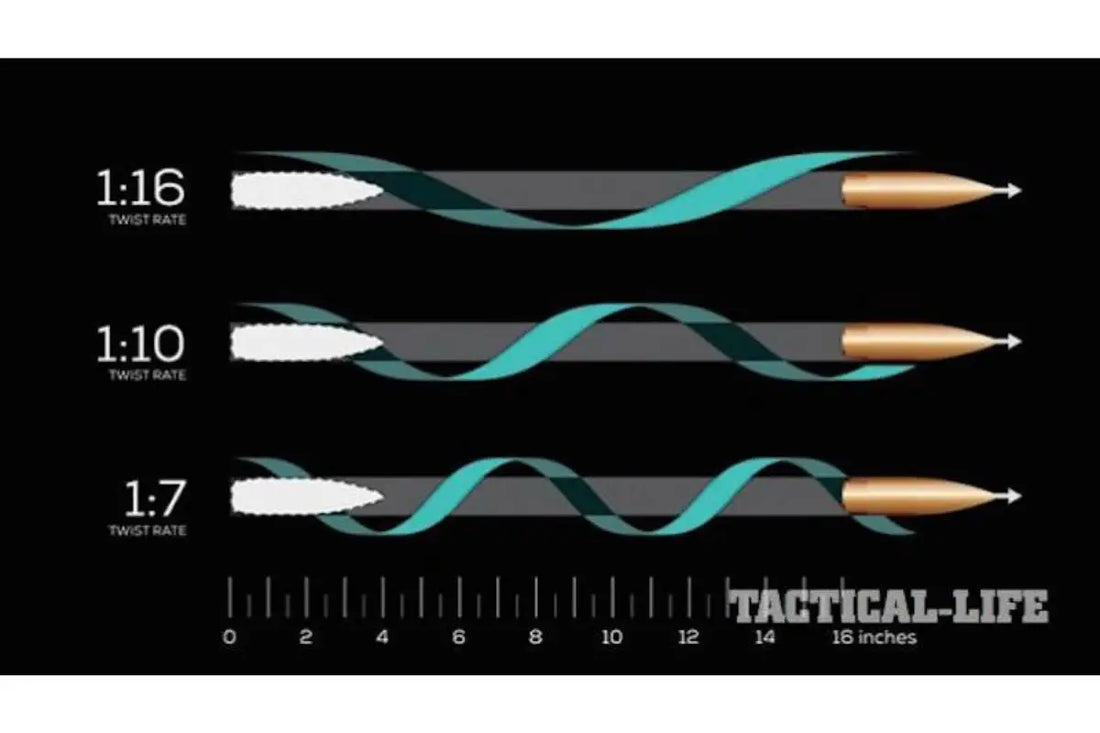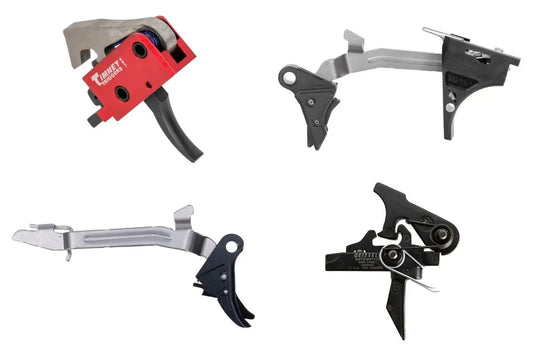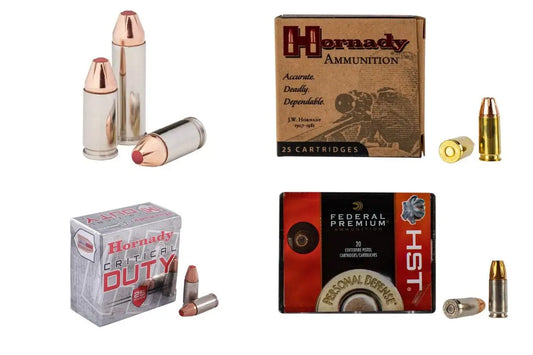
AR-15 Rifling Twist Rates, Demystified: The Smart Shooter’s Guide to Matching Twist to Bullet Weight
TL;DR for Skimmers
- Best single choice: 1:8 twist — reliably stabilizes 55–77 gr bullets, from cheap 55 FMJ practice ammo to heavy 77 gr match (great for target/hunting flexibility).
- Shoot mostly 55 gr? 1:9 is fine; 1:8 or 1:7 buys future-proofing.
- Varmints (40–50 gr)? 1:12–1:9 avoids “overspinning” fragile varmint bullets at high velocity.
- Heavier 62–77 gr / duty or match? 1:7–1:8 is optimal; 1:7 adds margin for long tracers/monos.
- Nerd note: What matters most is bullet length, velocity, and gyroscopic stability (SG)—aim for SG≈1.5–2.0 for best BC/precision. Use a modern calculator, not just the old Greenhill rule.
Quick Summary Table — Twist vs. Typical .223/5.56 Bullet Weights
|
Intended Bullet Weight |
Common Loads / Examples |
Recommended Twist |
Why It Works |
Pros |
Cons |
|
40–50 gr (varmint) |
40 V-Max, 45–50 TNT/Varmageddon |
1:12–1:9 |
Short, light bullets don’t need as much spin to stabilize |
Mild recoil, screaming velocity, explosive small-game performance |
Not ideal in wind; marginal stability in some 1:7 barrels at very low velocities |
|
55 gr (M193, FMJ, SP) |
XM193, 55 SP for coyotes |
1:9 (good); 1:8–1:7 (also fine) |
55s stabilize well in 1:9 and faster; 1:8/1:7 adds flexibility |
Widely available, accurate enough, works in nearly any modern AR |
Not as consistent past ~400 yds vs longer, heavier OTM |
|
62 gr (M855/SS109) |
M855 “green tip,” bonded 62 gr duty loads |
1:9 (minimum); 1:8–1:7 (optimal) |
Longer projectiles need more spin; 1:7 chosen to also stabilize tracer |
Good barrier performance (bonded), flatter than 70–77 gr |
Some 1:12 barrels won’t stabilize; 1:7 can “over-spin” very thin-jacket varmint bullets |
|
68–69 gr OTM |
68/69 gr Match (Hornady/Sierra/Nosler) |
1:9–1:8 |
Transitional class—works well in both 1:9 and 1:8 |
Good precision from 16" carbines; forgiving |
Slight BC handicap vs. 73–77 gr |
|
73–77 gr OTM / TMK |
73 ELD-M, 75/77 BTHP/SMK/TMK |
1:8 (minimum); 1:7 (assured) |
Long for caliber; needs faster twist for robust stability |
Proven accuracy to 600+ yds; excellent wind drift numbers |
1:9 often marginal; requires mag-length loading limits |
|
Copper 62–70 gr (monos) |
Barnes 62/70 TSX, GMX |
1:8–1:7 |
Copper bullets are longer for weight → need faster twist |
Great penetration for hunting |
Higher cost; sometimes seating depth sensitive |
Bottom line: If you want one twist to do almost everything in a 5.56/.223 AR, 1:8 is the sweet spot. It handles 55–77 gr well and gives you the headroom for modern, longer bullets.
Why twist rate matters (and what “1:7” actually means)
[Rifling twist rate] is how fast your barrel spins a bullet— “1:7” means one full revolution in 7 inches of barrel travel. Spin stabilizes the bullet so it flies point-forward; too little spin and the bullet yaws or “keyholes,” too much and you may slightly degrade peak accuracy with thin-jacket, light varmint bullets at extreme velocities. The classic Greenhill formula (1879) gives a ballpark twist from caliber and bullet length, but modern bullets benefit from updated math (e.g., Miller or Litz methods) and calculators that predict gyroscopic stability (SG) at your actual muzzle velocity. –An NRA Shooting Sports Journal
Target SG: Berger’s guidance is simple: SG ≥ ~1.5 tends to preserve advertised BC and downrange performance; marginal stability (SG 1.0–1.49) can shoot “okay” groups but leaves BC on the table. Faster twist often raises the “actual” BC by maintaining stable flight. –bergerbullets.com
A quick (and useful) history lesson
- The original M16 (with 55-gr M193) ran 1:12 twist—just right for those shorter FMJs.
- When NATO adopted the longer SS109/M855 and the U.S. wanted a single twist that would also stabilize tracer (M856), the M16A2 family went to 1:7. That’s why many modern AR-15s (especially “mil-spec-ish” barrels) are 1:7 today.
Bullet length, not just weight, drives twist needs
Two bullets of the same weight can require different twist rates because longer bullets (think copper monolithics or high-BC VLD/OTM profiles) have more overturning moment and need more spin. Examples frequently cited by practitioners:
- Sierra 77 gr MatchKing (SMK/TMK): requires 1:8 or faster—a factory statement from Sierra.
- M855 (62 gr): generally needs 1:9 or faster, with 1:7 providing extra margin and compatibility with tracer.
The practical recommendations (by use case)
1) “General-purpose carbine” (training, home, range, classes)
- Pick: 1:8 twist, 16" or 14.5" pinned.
- Why: Eats 55–77 gr without fuss; works with cheap 55 FMJ for volume and lets you step up to 73–77 gr match for matches/SPR-ish tasks.
- Real barrels to consider:
- Criterion CORE 16" (1:8) — hybrid profile that keeps weight modest and groups tight.
- Ballistic Advantage Hanson 16" (1:8) — proven balance of accuracy and handling.
- Daniel Defense CHF 16" (1:7) — if you want mil-leaning robustness with a twist that covers everything, including long tracer-length bullets.
- BCM Standard 16" (1:7) — duty-reliable, chrome-lined workhorse.
Pros: Maximum ammo flexibility; good accuracy with 69–77 gr; compatible with suppressors and short-barrel setups.
Cons: If your diet is exclusively fragile 40–50 gr varmint loads at 3,300–3,700 fps, a slower twist can be slightly kinder to ultra-thin jackets.
2) Varmint/predator rifle (explosive light bullets at high speed)
- Pick: 1:12–1:9, 18"–20" barrels.
- Why: Classic 40–50 gr bullets are short; a slower twist avoids unnecessary RPM on thin-jacket designs and often squeezes out top-end group consistency.
- Barrel examples:
- Wilson Combat 20" .223 Wylde (1:9) — versatile varmint twist with Wylde chamber for accuracy.
- White Oak Armament 20" Varmint (1:12 or 1:10 options) — optimized for lighter bullets and precision varminting.
- Faxon 18" .223 Wylde (1:8) — if you want a middle path that still lets you jump to 73–77 gr when wind comes up.
Pros: Laser-flat trajectories with 40–50 gr; minimized jacket stress.
Cons: You’ll give up heavy-for-caliber bullet options; wind drift is real past ~300–400 yards.
3) Duty/defense carbine (bonded 62–70 gr, barrier-blind)
- Pick: 1:7–1:8, 14.5"–16".
- Why: Modern bonded bullets and longer 62–70 gr projectiles (and some copper solids) appreciate the faster twist for robust stability across temps and barrel lengths.
- Barrel examples:
- Noveske CHF 14.5/16" (1:7) — excellent bore quality and longevity.
- FN-manufactured CHF 16" (1:7) — chrome-lined durability; a GI-style standard.
- LWRCI CHF NiCorr 16" (1:7) — another premium CHF option.
Pros: Stability headroom for “long for weight” bullets, including copper monolithics and tracer.
Cons: You may see slightly larger groups with very thin-jacket 40–45 gr at max speed (still usually fine for close-range pest control).
4) Precision/SPR (69–77 gr OTM, Mk 262-style)
- Pick: 1:7–1:8, 16"–20".
- Why: Keeps SG ≥ 1.5 with long 75/77 gr OTM/TMK profiles, especially as velocity drops from shorter barrels or colder weather. Sierra explicitly calls for 1:8+ on 77s. –sierrabullets.com
- Barrel examples:
- CLE/Compass Lake 18–20" .223 Wylde (1:7.7–1:8) — a gold standard for Service Rifle/SPR builds.
- Krieger/Criterion stainless 18–20" (1:7.7–1:8) — cut- or button-rifled match tubes with consistent bores.
- Proof Research 18" Carbon (1:8) — lightweight, rigid, with match potential.
Pros: Excellent precision potential to 600+; best wind performance for gas-gun .223.
Cons: Ammo is pricier than 55 FMJ; requires careful load or match-grade factory selections.
Pairing ammo to twist (concrete, “buy-it-today” guidance)
Rule of thumb: 1:8 covers 55–77 gr. If your barrel is 1:9, stay ≤69 gr for stress-free accuracy; if 1:7, feel free to run anything from 55 to 77 gr, but favor 62–77 gr for best precision.
- If your barrel is 1:12:
- Stick to 40–55 gr (e.g., Hornady 50 V-Max, 55 SP).
- Expect M855 (62 gr) to be unstable or inaccurate.
- If your barrel is 1:9:
- Great with 55–69 gr (Hornady 68 BTHP, Sierra 69 SMK).
- M855 (62 gr): generally fine. 75–77 gr: often marginal, but some rifles shoot them acceptably; your mileage may vary.
- If your barrel is 1:8:
- Ideal “do-all”: 55–77 gr (Sierra 77 SMK/TMK specifically require 1:8+). Pair with 73 ELD-M, 75 BTHP, 77 SMK/TMK for distance; throw in 55 FMJ for volume practice.
- If your barrel is 1:7:
- Optimized for 62–77 gr (and tracer). 55s still work fine for training, but you’ll likely see your best groups from 69–77 gr OTM or bonded 62–64 gr duty loads. Historically chosen to stabilize M856 tracer, not because M855 “needed” 1:7 in isolation.
“Over-stabilization” and other myths—what actually matters
Shooters often worry that a fast twist will “blow up” light bullets. The truth is nuanced:
- Jacket failure can happen with very thin-jacket varmint bullets at extreme velocities and very fast twists—but it’s uncommon in 5.56 AR velocities. What you’ll more often see is simply slightly larger groups with fragile 40–45 gr pills in 1:7 compared to 1:12–1:9. –Everyday Marksman
- Stability margin improves BC retention: Berger’s data show that bumping twist to push SG over ~1.5 helps the bullet maintain its advertised BC—you’ll often gain net precision and consistency, not lose it. –bergerbullets.com
- Velocity matters: For the same twist, short barrels and cold temps reduce muzzle velocity, which reduces SG. That’s why a 77 gr load that’s stable from a 20" may go marginal in a suppressed 10.3" SBR unless the twist is sufficiently fast (This is exactly why duty-type guns lean 1:7).
What industry experts say
- Sierra Bullets (77 SMK/TMK): “This bullet requires a barrel twist rate of 1×8” or faster.” (Product pages for 77 SMK/TMK.)
- Berger Bullets (stability guidance): “Increasing the twist rate to 1:11” or faster… results in this bullet achieving a stability factor greater than 1.5, and allows it to fly with a higher actual BC.” (On why adequate SG boosts effective BC).
- NRA/SSUSA (on Greenhill): The Greenhill formula remains a simple way to estimate twist, though “updated math and software programs” supersede it for modern bullet designs.
- U.S. Army FM 3-22.9 (M16/M4): “The M16A2/A3/A4 and the M4 carbine has a 1:7 barrel twist…” (reflecting the tracer-compatibility requirement baked into A2 spec).
Specific product picks (by mission), with rationale
Note: We’re intentionally choosing top-tier, meticulously made components. You’ll find cheaper options, but these are builds we’d stake a match or a hunt on.
General-Purpose / Training-to-Match:
- Criterion CORE 16" .223 Wylde, 1:8 — Exceptional bore finish, hybrid profile that stays rigid. Pairs beautifully with 55 FMJ for training and 77 SMK for accuracy days.
- Ballistic Advantage Hanson 16" .223 Wylde, 1:8 — Consistently good groups; taper profile balances heat and handling.
- Daniel Defense CHF 16" 5.56, 1:7 — Mil-leaning durability; eat anything including M855 and 77 OTM.
Varmint/Predator (flat-shooters):
- White Oak Armament 20" .223 match, 1:12 or 1:10 — Tune around 40–50 gr pills for pelt-friendly precision.
- Wilson Combat 20" .223 Wylde, 1:9 — A flexible “slow-ish” twist that still runs 55–69 gr well.
SPR/Precision:
- Krieger 18–20" stainless, 1:7.7–1:8 — When you’re chasing .5–.8 MOA with 75–77 gr OTM.
- CLE/Compass Lake .223 Wylde 18–20", 1:7.7–1:8 — Service Rifle & SPR pedigree.
- Proof Research 18" Carbon, 1:8 — Lightweight without giving up precision potential.
SBR/Suppressed “Everything Gun”:
- Noveske CHF 12.5" 5.56, 1:7 — Suppressor-friendly gas, 1:7 stabilizes long bullets at SBR velocities.
- BCM 11.5" Govt 1:7 — Bomb-proof, pairs with 62–77 gr for best consistency.
(If you run primarily copper monos like Barnes TSX 62/70 or Hornady CX, favor 1:7–1:8; copper is longer for weight.)
Deep-dive: How to sanity-check your barrel/ammo combo
- Pick two reference loads that bracket your use—say 55 FMJ and 77 SMK.
- Zero and group both at 100 yards. If groups are round with no keyholes, you’re at least statically stable.
- Stretch to 300–400 yards and watch group shape and vertical. If your heavy bullet suddenly opens up or prints odd fliers in wind, your SG may be marginal for that bullet at your velocity.
- Use a stability calculator (e.g., Berger’s) with your bullet’s actual length and your chronograph velocity to check SG in your conditions (account for cold weather). Aim for SG≥1.5.
Pro tip: If you’re hovering at SG 1.3–1.4, a small bump in velocity (hotter load, longer barrel, warmer temps) or a slightly faster twist often turns a “meh” long-range performer into a solid one.
FAQ (the stuff people argue about on the range)
-
Will 1:7 “over-stabilize” 55-gr M193 and wreck accuracy?
Not in a practical sense. Many 1:7 carbines shoot 55s just fine for training. Peak precision might favor a slower twist, but the difference is typically modest until you push tiny, thin-jacket varmint bullets really fast. -
Is 1:9 good enough for 75/77s?
Sometimes at sea level with hot loads and longer barrels, but often marginal. If you want heavy OTMs to shine in all-weather/barrel lengths, go 1:8 or 1:7. -
Why did the military pick 1:7 for M855 if 1:9 works?
Tracer length drove the spec; 1:7 was adopted to stabilize the long M856 tracer, ensuring one universal twist. -
Does faster twist increase barrel wear?
Wear is dominated by pressure/heat/erosion, not twist alone. A high-quality CHF or cut-rifled barrel treated well will typically outlast the accuracy life you demand from it regardless of 1:7 vs 1:8. -
What about .223 Wylde vs 5.56 chambers?
Chamber has nothing to do with twist; Wylde is a throat geometry balancing 5.56 pressure compatibility and .223 match accuracy.
Pros & Cons of the common AR twist rates
1:12
- Pros: Perfect for classic 40–55 gr varmint bullets; top velocities with thin-jackets; historically accurate for retro builds.
- Cons: Won’t properly stabilize 62–77 gr; limits modern do-all use.
1:9
- Pros: Great for 55–69 gr; fine with M855; simple, inexpensive barrels abound.
- Cons: Often marginal for 75/77 gr—especially from short barrels/cold temps.
1:8 (our go-to recommendation)
- Pros: Sweet spot across 55–77 gr; supports modern long-for-weight bullets; outstanding for GP carbines and SPRs alike.
- Cons: None that matter for most shooters; hyper-fragile 40–45 gr at max speed may group a hair tighter in slower twists.
1:7
- Pros: Maximum stability margin for 62–77 gr, copper monos, and tracer; ideal for SBRs/suppressors.
- Cons: Slightly less forgiving with ultralight varmint bullets at extreme speeds (still usable).
Concrete ammo pairings (that consistently “just work”)
- Training/steel: 55 FMJ (M193-type) — shoots fine in 1:9, 1:8, 1:7.
- Low-cost accuracy: 68/69 gr OTM (Hornady/Sierra/Nosler) — thrives in 1:9–1:8.
- Match/SPR: 73 ELD-M, 75 BTHP, 77 SMK/TMK — pick 1:8–1:7 (Sierra explicitly calls 1:8+).
- Duty/defense: 62–64 gr bonded (e.g., Federal TBBC 62, Gold Dot 64) — 1:8–1:7 preferred.
- Copper hunting: Barnes TSX 62/70 — these are long; favor 1:8–1:7.
Recommended path (opinionated, because you asked)
If you’re buying one AR barrel today and want maximum capability with minimal compromise, get a top-tier 16–18" .223 Wylde, 1:8. Feed it 55s for bulk practice and 77s when you care about hits in the wind. If you specialize—say prairie dogs at 350 yards with 40–50 gr—choose a 1:12–1:10 varmint profile. If you’re mostly shooting bonded 62–70 gr or you run a short/suppressed carbine in all weather, go 1:7 and don’t look back.
Why 1:8 as the default? It’s the widest operating envelope for modern .223/5.56 bullets, and authoritative sources and real-world use have converged on it as the most versatile twist for AR-15s.
Shop premium AR barrels and match ammo at PrimaryArms.com.




